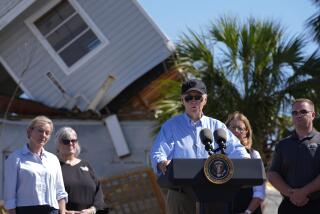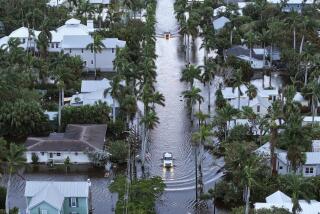Floods Force More Out of Homes; Summit Held : Disaster: Clinton, Gore tour St. Louis area and talk to Midwest governors. Labor secretary hands out checks.
ST. LOUIS — Rampaging water drove more people out of their homes Saturday in the Midwest as President Clinton held a flood summit and offered to send federal troops. State officials asked for money, so Clinton’s labor secretary handed out checks for millions of dollars in aid.
Clinton arrived in St. Louis as victims counted huge losses from the Mississippi and Missouri rivers, which flowed together across a hapless peninsula north of here; the Des Moines River, which took another punch at a levee in downtown Des Moines; and the Red River, which eased up, along with the rain, to let Fargo, N.D., start drying out.
Clinton and Vice President Al Gore flew over the new confluence of the Mississippi and the Missouri in separate helicopters. They met afterward at a high school in suburban Arnold, Mo., with the governors of eight states and a top official from a ninth and talked publicly for two hours about how the government could help with flood relief.
None of the state officials took Clinton up on his offer of troops. Most asked for financial assistance. Labor Secretary Robert B. Reich, among eight Cabinet members who accompanied the President, announced he had checks. He handed a blue folder to Minnesota’s chief executive. “Gov. Carlson,” he said, “there’s a million.”
Reich said that officials from some states had asked for aid to give cleanup jobs to the unemployed. He said his department already had processed their requests. “Why don’t I just pass out the checks?”
In a political epiphany ideal for TV, the President beamed, and the governors from states yet to apply looked on longingly.
The weather was a more difficult problem. Gore, using maps prepared with help from experts, described powerful forces of nature causing torrential rains across the Midwest. Because of the rain and the flooding, he said, “It is as if another Great Lake has been added. . . . Very shallow and temporary, but another Great Lake.”
Forecasters said there would be no letup. After a day of heavy rain in parts of the Dakotas, Minnesota, Illinois, Iowa and Nebraska, the National Weather Service predicted thunderstorms and heavy rain across all of Iowa and parts of Missouri, Illinois, Kansas, Minnesota and Wisconsin.
Missouri
The President’s helicopter took him over a peninsula flooded by the Mississippi and Missouri rivers, which includes West Alton and farmland that was home to Mike Farley, 47, and his brother and sister-in-law. Now it is a huge sea dotted with the tops of houses, which look like strange islands.
“We have a farm about four miles from here, where the Missouri and Mississippi meet--make that where they used to meet,” said Farley, whose family has a 1,700-acre farm that usually produces wheat, corn and soybeans. “Now they’re meeting way up above where we are now.”
The Farleys, whose farm is near the starting point of the Lewis and Clark expedition, figure they will lose crops valued at close to $300 an acre.
“Every farmer up and down the river is going to have that kind of loss. Luckily, we saved money,” Farley said. “All we can do is hope it does not happen again next year.”
Donna Farley, 45, sat in a metal, flat-bottomed motorboat waiting to return to her submerged home. “Fish swim by your feet when you’re walking in your house,” she said. “There are lots of snakes in the window sills and stacks of toads everywhere.
“It’s like living in a lake resort--if it weren’t for our house being in water.”
Some residents returned to homes abandoned a week ago to retrieve belongings stowed in places that they had thought would stay dry--but now were threatened. Laura Lewis made the trip by boat to her brother and sister-in-law’s home to fetch a dress she plans to wear for her wedding.
“We’re going to have a great memory to tell about the dress at the wedding,” Sonya Lewis, Laura’s sister-in-law, said as a U.S. Coast Guard flat boat carried the trio--and the dress--back from their sunken home.
But what the Lewis family found at home was heartbreaking.
A renovation that had taken years of hard work and cost $6,000 was destroyed. The family has no insurance. With four children, they had used their money to pay doctor bills.
Worse than property damage was human disaster. To avoid adding to the Midwest death toll, which stood at 27, police evacuated 500 residents just south of St. Louis, where the River Des Peres was pinpointed as a possible trouble spot.
Officials feared it might flood when the crest of the Mississippi passes sometime today.
Iowa
In Des Moines, officials ordered the evacuation of 700 homes and businesses after a city surveyor spotted a 50-foot gouge opening in a downtown levee.
Within five minutes, National Guardsmen, city employees and Army engineers were running to the dike with tree limbs, sandbags and broken concrete. Bulldozers pushed tons of clay up the backside of the levee.
“This flood is beyond all comprehension,” declared Lt. Col. Thomas G. Ayres, commander of the Army Corps of Engineers working feverishly to stop the erosion caused by the rushing floodwater in the Des Moines River. “(This levee) was never intended to withstand this kind of onslaught.”
John Allen, 34, heard about the crisis on a police scanner. It was 9 a.m.
“I went down to beat on the doors to make sure people were awake,” he said. “A lot of my friends are down in that area. . . . They were scared. . . . I saw people carrying their TVs and clothes, whatever they could.”
Shirley and Jack Davidson were among those who fled. They watched the work on the levee from a nearby bridge. Shirley Davidson barely held back her tears. Her hand shook as she wiped her brow. “My pictures,” she said, “are still on the fireplace mantel.”
After several hours of frantic effort, City Manager Cy Carney declared the levee stabilized. He reduced the evacuation order to 300 homes and said that the crisis would not affect plans to begin restoring tap water to residents starting Monday. They have been without water for a week.
Water safe to drink was still a month away.
“We were within one hour or less,” Carney said, “of losing the entire levee.”
North Dakota
In Fargo, homes began the long process of drying out after suffering the most severe flooding in memory.
There and across the Red River in Moorhead, Minn., residents hung out soggy carpets and clothing and drained cellars and swampy back yards into fields and streets.
Up to eight inches of rain had fallen in some areas of the twin cities in less than 24 hours, and the river rose four inches. Authorities said water and sewage backed up into more than half of the homes in Fargo and flooded untold acres of farmland.
Two youths were rescued from the river, which twists through the area like a Christmas ribbon, and the Fargo Fire Department answered emergency calls for pumping assistance.
“We are holding on,” Mayor Jon Lindgren said, “and watching.”
The Summit
At the flood summit, open to television coverage, the President and vice president appeared in their competent-but-folksy manner. Clinton wore a raspberry- polo shirt; Gore, seated next to him, wore blue jeans and cowboy boots.
The President offered federal troops to states whose National Guard contingents were growing exhausted. Only Illinois has indicated that its troops might be reaching their limits, and there were no takers.
Instead, the governors asked for cash. Gov. Tommy G. Thompson said loans would not do. “We are really beyond borrowing any more money,” he said. Nor, said Gov. Jim Edgar of Illinois, can states afford to put up matching funds. “Everybody is strapped.”
Clinton and his Cabinet replied that they would waive rules wherever they could. Clinton also said the Agriculture Department will “review” guidelines that now limit assistance payments for damaged crops to little more than 20 cents on the dollar.
Clinton has asked Congress for $2.48 billion in flood relief. He said, as he had before, that his request would grow--but he did not say by how much. He and Leon E. Panetta, his budget director, said that their generosity was not unlimited. “It’s not,” the President said, “a question of holding people harmless.”
The idea, he said, is to give them “a fighting chance.”
Richter reported from Arnold, Mo., and Shogren from St. Louis. Times staff writers Dean E. Murphy in Fargo, N.D., Judy Pasternak in Niota, Ill., Tracy Shryer in Des Moines, Iowa, Lianne Hart in St. Louis and Richard E. Meyer in Los Angeles contributed to this story.
More to Read
Sign up for Essential California
The most important California stories and recommendations in your inbox every morning.
You may occasionally receive promotional content from the Los Angeles Times.











